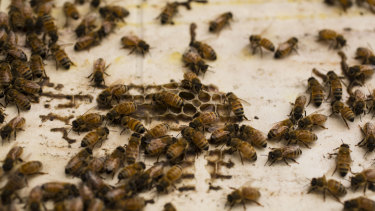
The varroa mite, which is deadly to honey bees, has been detected along the Central Coast as authorities increase the number of beehives set to be destroyed in a bid to control the spread of the parasite.
NSW Department of Primary Industries acting chief plant protection officer Chris Anderson said the agency had established an emergency biosecurity zone around a property in Calga, west of Gosford, which became effective on Thursday.

A biosecurity zone has been created on the Central Coast as authorities race to control the spread of the varroa mite. Credit:Dominic Lorrimer
“Since varroa mite was first identified at the Port of Newcastle last week, NSW DPI has been working with apiary industry bodies and stakeholders to ensure beekeepers are informed and empowered to be part of this critical response,” he said.
“So far many of the [nine] infested premises have been located very close together so the emergency zones covered largely the same areas but recent detections at Bulahdelah [north of Newcastle] and Calga have expanded the area.”
Australia was one of the few countries without the mite, but the Varroa destructor, commonly called the varroa mite, was detected in surveillance bees at the Port of Newcastle last week. The mite affects European honey bees’ ability to fly, gather food, or emerge from their cells to be born.
NSW authorities established biosecurity zones in Newcastle and the Mid North Coast on Wednesday after the mites were detected at eight properties, with those in a 10-kilometre radius to be destroyed. Hives within a 25 and 50-kilometre radius will undergo surveillance.
Victoria and Queensland have issued orders restricting the movement of bees from NSW into their states, while NSW has issued a statewide standstill of bees, hives and equipment after the mites were detected.
Earlier this week, the government said more than 600 hives had been destroyed in the Newcastle region, but this number is likely to grow in the coming days.









 Add Category
Add Category